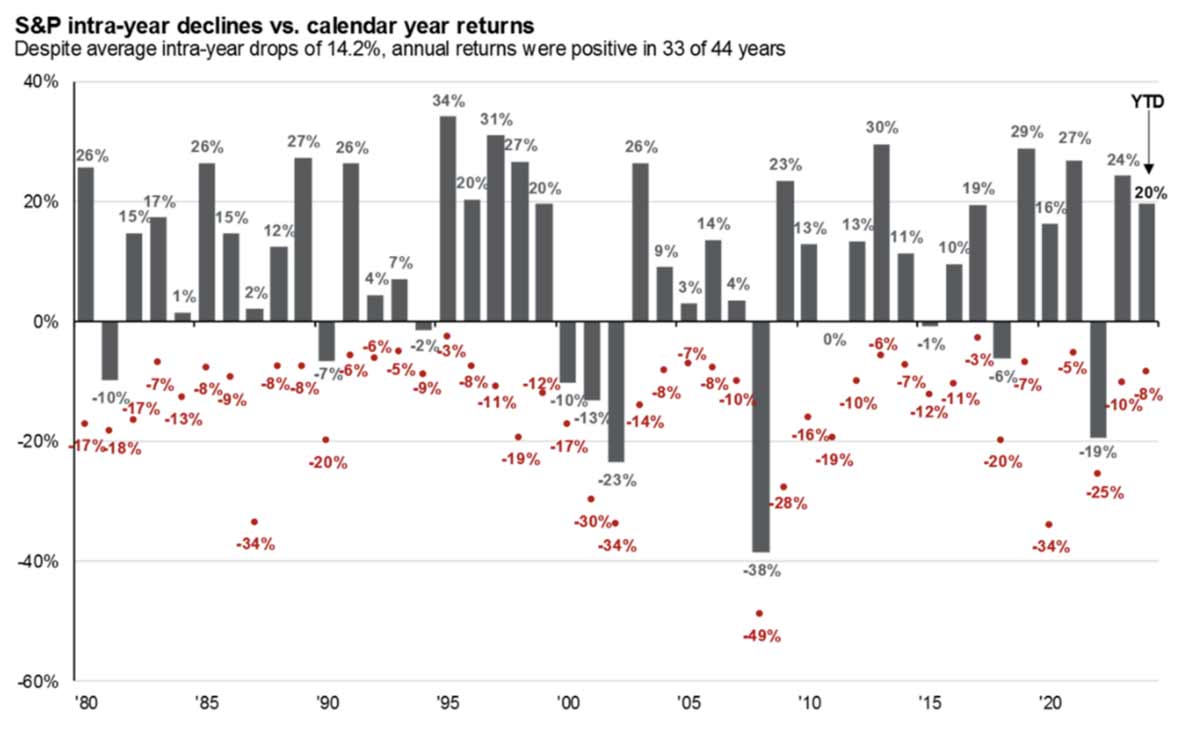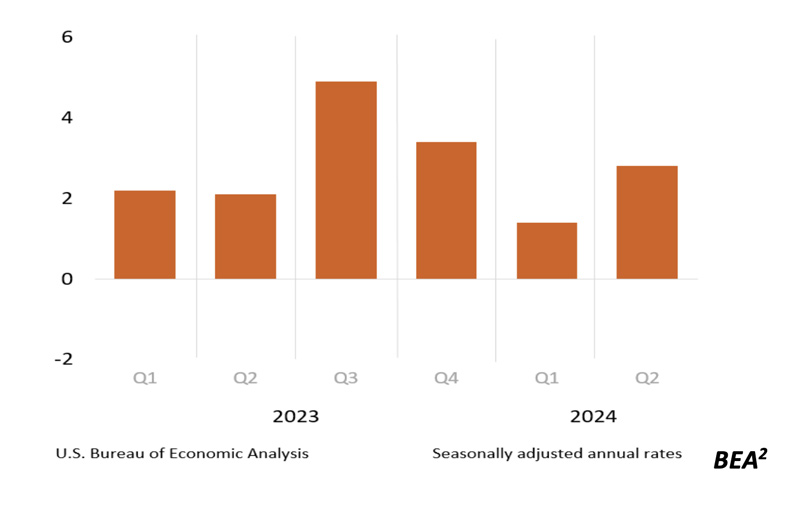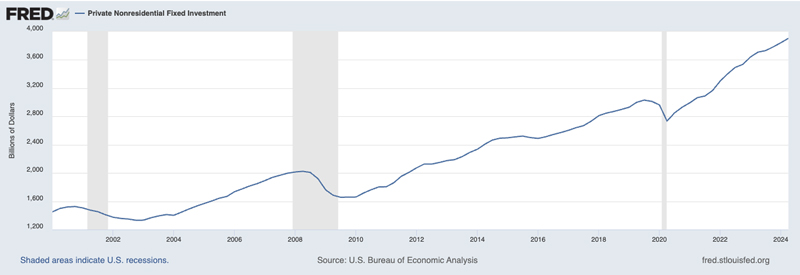
At the outset of 2024, most large banks were forecasting the S&P 500 Index to finish around 5,200, which would have implied a roughly 10% gain for the year. U.S. stocks had different plans.
Bolstered by stronger-than-appreciated U.S. consumer spending, steady economic and earnings growth, declining inflation, and the Federal Reserve’s pivot to looser monetary policy, U.S. stocks have delivered a rally over double the magnitude of most expectations.1
The U.S. presidential election seems to have catalyzed the momentum. In the week following the election, the S&P 500 Index jumped +4.7% – the strongest week since October 2022. I’ve argued before that the ‘removal of uncertainty’ was a key driver of this short-term market strength, but I also think it’s fair to say the market was pricing-in hopes for lower taxes and lighter regulation, both of which could promote growth.
The question for investors is, can this post-election rally continue through the end of the year?
I think it can.
The first factor I’d consider is seasonal. Looking back to 1950, December ranks as the second-best performance month for the S&P 500, with an average gain of 1.3%. But December is also the most consistently positive month, with the highest frequency of advances of any month with the lowest volatility (based on data since 1950). On average, gains have been broad-based, but small- and mid-caps have tended to outperform historically.
Strong gains leading up to December have also ushered in a strong close to the year. In the last ten instances when the S&P 500 Index entered December up more than +20%, the final month saw an average gain of +2.4%. In this historical context, strong gains beget more strong gains.
I also think the market could keep pricing-in major policy shifts as the new administration’s agenda comes into clearer focus. The prospect of sizable fiscal stimulus (tax cuts) into an economy that’s already growing roughly 2.5% to 3% could be a significant catalyst to growth, and it could also mean adding to an already historically large U.S. fiscal deficit. In my view, this could put upward pressure on long-duration U.S. Treasuries, which could finally un-invert and eventually steepen the yield curve (Fed rate cuts would also help). A steeper yield curve would arguably help Financials while also having the potential to stimulate more lending, an economic positive.
The Yield Curve Could Steepen with Further Fed Cuts and Rising Long-Duration Treasury Yields

Source: Federal Reserve Bank of St. Louis2
Finally, no commentary about the potential for more stock market appreciation would be complete without talking about earnings.3
For the third quarter, total earnings for the S&P 500 index are expected to be up +8.1% from the same period last year on +5.7% higher revenues. If we exclude the volatile Energy sector, whose Q3 earnings were down -22.9% from the same period last year on -2.7% lower revenues, then earnings would have been up +10.6% on +6.3% higher revenues. This level of solid earnings growth has been present throughout 2024, and as seen on the chart below, is expected to accelerate in the new year:
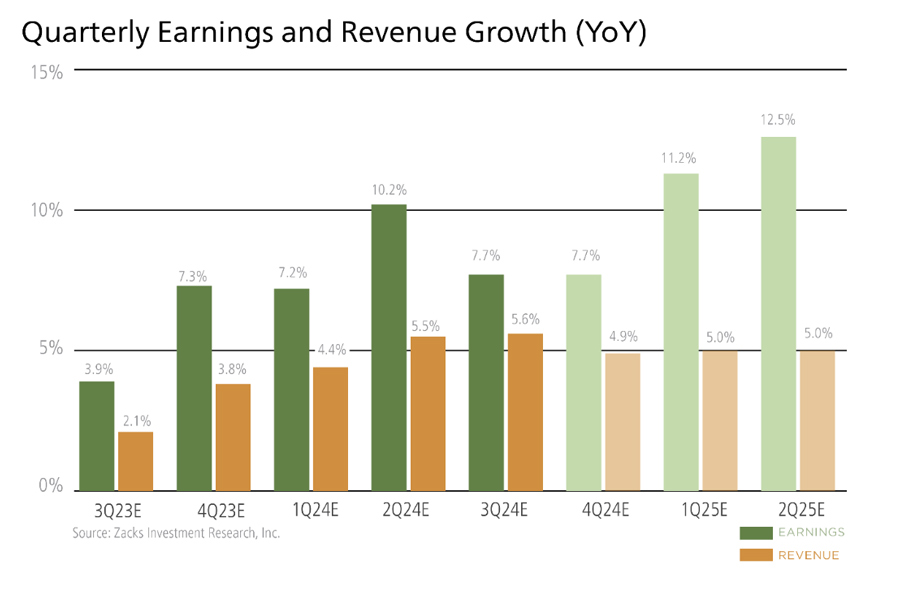
A final point to make on earnings is that unlike the unusually high magnitude of estimate cuts we had seen ahead of the Q3 earnings season, estimates for Q4 are holding up a lot better, as the chart below shows. Heading into the final stretch, companies are feeling more confident about sales and earnings than they were previously.
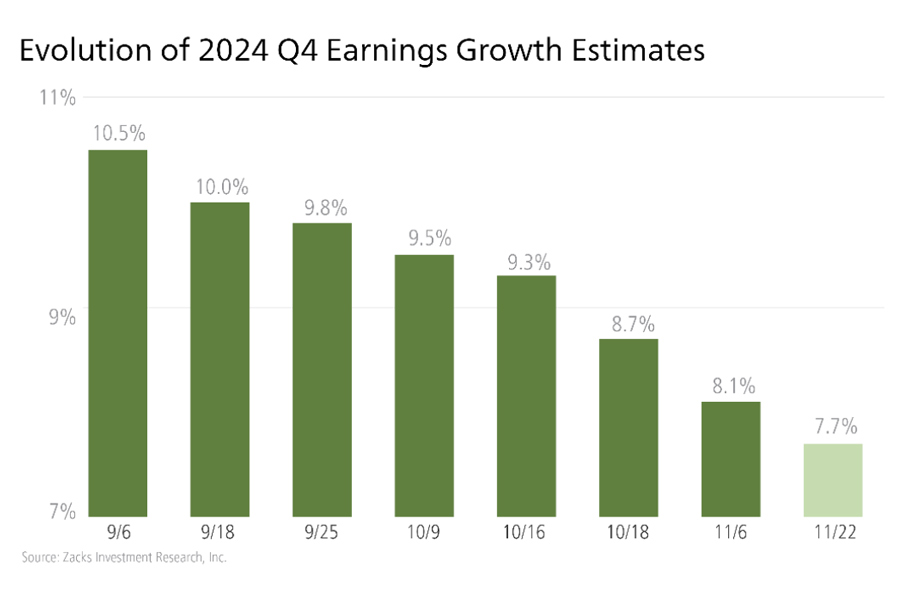
Bottom Line for Investors
I want to be clear that while I think stocks can continue to rally into the end of the year and early next, based on the factors laid out above, I am not suggesting they will rally. No one can truly predict what stocks will do in the short term, and downside volatility and/or a correction can occur at any time and for any reason.
Thinking further ahead, I do think economic fundamentals remain supportive of higher equity prices, and earnings and economic growth could benefit from lower taxes and looser regulation. In other words, the ingredients for more equity market gains are present, it’s just a matter of whether the realities of those policies and growth will meet and/or exceed expectations. For now, I think they can.
1 Black Rock. November 20, 2024. https://advisor.zacksim.com/e/376582/vidual-insights-election-rally/5s8v1t/1098587475/h/lpAEtTBFFKn6Ol5QwGYSy7rFtGjMG6N-c6dLF5__9Rw
2 Fred Economic Data. December 3, 2024. https://advisor.zacksim.com/e/376582/seriesBeta-T10Y3M-/5s8v1x/1098587475/h/lpAEtTBFFKn6Ol5QwGYSy7rFtGjMG6N-c6dLF5__9Rw
3 Zacks.com November 22, 2024. https://advisor.zacksim.com/e/376582/-stock-of-the-earnings-picture/5s8v24/1098587475/h/lpAEtTBFFKn6Ol5QwGYSy7rFtGjMG6N-c6dLF5__9Rw
DISCLOSURE
Past performance is no guarantee of future results. Inherent in any investment is the potential for loss.
Zacks Investment Management, Inc. is a wholly-owned subsidiary of Zacks Investment Research. Zacks Investment Management is an independent Registered Investment Advisory firm and acts as an investment manager for individuals and institutions. Zacks Investment Research is a provider of earnings data and other financial data to institutions and to individuals.
This material is being provided for informational purposes only and nothing herein constitutes investment, legal, accounting or tax advice, or a recommendation to buy, sell or hold a security. Do not act or rely upon the information and advice given in this publication without seeking the services of competent and professional legal, tax, or accounting counsel. Publication and distribution of this article is not intended to create, and the information contained herein does not constitute, an attorney-client relationship. No recommendation or advice is being given as to whether any investment or strategy is suitable for a particular investor. It should not be assumed that any investments in securities, companies, sectors or markets identified and described were or will be profitable. All information is current as of the date of herein and is subject to change without notice. Any views or opinions expressed may not reflect those of the firm as a whole.
Any projections, targets, or estimates in this report are forward looking statements and are based on the firm’s research, analysis, and assumptions. Due to rapidly changing market conditions and the complexity of investment decisions, supplemental information and other sources may be required to make informed investment decisions based on your individual investment objectives and suitability specifications. All expressions of opinions are subject to change without notice. Clients should seek financial advice regarding the appropriateness of investing in any security or investment strategy discussed in this presentation.
Certain economic and market information contained herein has been obtained from published sources prepared by other parties. Zacks Investment Management does not assume any responsibility for the accuracy or completeness of such information. Further, no third party has assumed responsibility for independently verifying the information contained herein and accordingly no such persons make any representations with respect to the accuracy, completeness or reasonableness of the information provided herein. Unless otherwise indicated, market analysis and conclusions are based upon opinions or assumptions that Zacks Investment Management considers to be reasonable. Any investment inherently involves a high degree of risk, beyond any specific risks discussed herein.
The S&P 500 Index is a well-known, unmanaged index of the prices of 500 large-company common stocks, mainly blue-chip stocks, selected by Standard & Poor’s. The S&P 500 Index assumes reinvestment of dividends but does not reflect advisory fees. The volatility of the benchmark may be materially different from the individual performance obtained by a specific investor. An investor cannot invest directly in an index.
The Russell 1000 Growth Index is a well-known, unmanaged index of the prices of 1000 large-company growth common stocks selected by Russell. The Russell 1000 Growth Index assumes reinvestment of dividends but does not reflect advisory fees. An investor cannot invest directly in an index. The volatility of the benchmark may be materially different from the individual performance obtained by a specific investor.
Nasdaq Composite Index is the market capitalization-weighted index of over 3,300 common equities listed on the Nasdaq stock exchange. The types of securities in the index include American depositary receipts, common stocks, real estate investment trusts (REITs) and tracking stocks, as well as limited partnership interests. The index includes all Nasdaq-listed stocks that are not derivatives, preferred shares, funds, exchange-traded funds (ETFs) or debenture securities. An investor cannot invest directly in an index. The volatility of the benchmark may be materially different from the individual performance obtained by a specific investor.
The Dow Jones Industrial Average measures the daily stock market movements of 30 U.S. publicly-traded companies listed on the NASDAQ or the New York Stock Exchange (NYSE). The 30 publicly-owned companies are considered leaders in the United States economy. An investor cannot directly invest in an index. The volatility of the benchmark may be materially different from the individual performance obtained by a specific investor.
The Bloomberg Global Aggregate Index is a flagship measure of global investment grade debt from twenty-four local currency markets. This multi-currency benchmark includes treasury, government-related, corporate and securitized fixed-rate bonds from both developed and emerging markets issuers. An investor cannot invest directly in an index. The volatility of the benchmark may be materially different from the individual performance obtained by a specific investor.
The ICE Exchange-Listed Fixed & Adjustable Rate Preferred Securities Index is a modified market capitalization weighted index composed of preferred stock and securities that are functionally equivalent to preferred stock including, but not limited to, depositary preferred securities, perpetual subordinated debt and certain securities issued by banks and other financial institutions that are eligible for capital treatment with respect to such instruments akin to that received for issuance of straight preferred stock. An investor cannot invest directly in an index. The volatility of the benchmark may be materially different from the individual performance obtained by a specific investor.
The MSCI ACWI ex U.S. Index captures large and mid-cap representation across 22 of 23 Developed Markets (DM) countries (excluding the United States) and 24 Emerging Markets (EM) countries. The index covers approximately 85% of the global equity opportunity set outside the U.S. An investor cannot invest directly in an index. The volatility of the benchmark may be materially different from the individual performance obtained by a specific investor.
The Russell 2000 Index is a well-known, unmanaged index of the prices of 2000 small-cap company common stocks, selected by Russell. The Russell 2000 Index assumes reinvestment of dividends but does not reflect advisory fees. An investor cannot invest directly in an index. The volatility of the benchmark may be materially different from the individual performance obtained by a specific investor.
The S&P Mid Cap 400 provides investors with a benchmark for mid-sized companies. The index, which is distinct from the large-cap S&P 500, is designed to measure the performance of 400 mid-sized companies, reflecting the distinctive risk and return characteristics of this market segment.
The S&P 500 Pure Value index is a style-concentrated index designed to track the performance of stocks that exhibit the strongest value characteristics by using a style-attractiveness-weighting scheme. An investor cannot directly invest in an index. The volatility of the benchmark may be materially different from the individual performance obtained by a specific investor.

